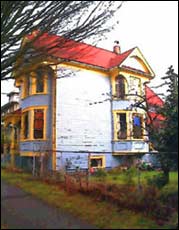 |
|
| The "Shingle King's" house |
NEW YORK (CNN/Money) -
In the classic comedy, "Mr. Blandings Builds His Dream House," a crafty real estate broker persuades Cary Grant to buy a disintegrating old dump.
In the movie, Grant falls for a dubious anecdote claiming that a Revolutionary War general stopped at the house on his way to the Battle of Somewhere-or-other. But are real people equally easy marks for this sort of blandishment?
Larry Fermi, a house historian in New Jersey, says an interesting history can help transform house shoppers into buyers. In fact, several brokers have asked him to produce histories they could "use as selling tools."
True, important historical connections, however, are rare and difficult to confirm.
"I won't say George Washington slept there unless there's primary source document," Fermi says. "The fact is, there are more attributions that Washington slept somewhere than he had nights to sleep."
The price of fame
James Larsen, a professor of business at Wright State, studies the effects of various events on house values. For many people, he says, a historical or celebrity connection is worth something, although he cannot quantify exactly how much.
Even notoriety can affect value. For many big old houses converted into bed and breakfast inns, "it's really important to have a story," says Larsen. A resident ghost, for example, is good for a B&B.
A grisly murder, though, usually lowers resale values, according to Larsen, whose father owns a house where the serial killer Jeffrey Dahmer once lived. Even though no crimes occurred there, it's still not much of a selling point.
On the other hand, time can heal some stigmas. Grace DuMelle, of Heartland Historical Research in Chicago, says one of her clients is actually eager to learn about possible gangland connections.
| Related articles
|

|
|
|
|
"He would be happy if any of three or four stories handed down to him panned out," she says. One is that "the killer and bank robber Alvin Karpis once hid out in his basement." But legends about the last of the original public enemies are not the easiest to verify.
Prosaic histories are more common. James Johnstone, of Home History Research in Vancouver, once studied a house and found it was built in 1900 by James McNair, "the Shingle King of British Columbia."
"His mill on the north shore was known as the largest shingle mill in the world," says Johnstone. That's interesting enough for the new owner, but not likely to add a lot to the home's worth.
Pride of place
The usual reason for hiring house historians is not to pump up a resale price. Most clients are just proud owners with no intention of selling.
Such people "usually like history and have a fond feeling for their neighborhood," says Johnstone. "Having a history done on their house makes them feel more connected to it." Their kids often commission reports as anniversary or birthday gifts.
The price of a pedigree reflects the amount of research put into it. DuMelle and Fermi both charge at least $2,000 for a full work-up. Johnstone starts at about C$500, but greater detail can bring in as much as C$3,000.
Homeowners with time, energy, and research skills might want to tackle the job themselves. For advice, consult local libraries or historical societies and go to the Web site of the National Trust for Historic Preservation. Some may hope to gain a spot on the National Registry of Historic Houses, or a place on the local annual heritage house tour.
Tracing a home's pedigree takes time. DuMelle says her genealogies are "very detailed, like a Master's thesis. We look mostly at primary sources, go into censuses, city directories, and look at previous owners."
Research can take unexpected turns. Larry Fermi says one house reputed to be from the early 1800s and built by Hyde Parker, a prominent early resident, "actually went back another two generations."
He confirmed the age of the house by examining the type of nails used in construction. "The use of rosehead nails stopped around 1800," he says.
 |
YOUR E-MAIL ALERTS
|
Follow the news that matters to you. Create your own alert to be notified on topics you're interested in.
Or, visit Popular Alerts for suggestions.
|
|
|
The research can enrich the owners' appreciation for the house in subtle ways. Some of the documents from the mid-19th century described how many cattle and sheep the resident family owned, and the number of bushels of corn and apples the farm produced. "It gives a picture of what life was like back then," says Fermi.
Of course, results can be disappointing, too.
DuMelle says one client was convinced someone rich and important had built his house, the only graystone building on an otherwise undistinguished block. Instead, DuMelle found that the builder was an immigrant from Lithuania who "rented out every extra square foot of space," to pay for the expensive construction.

|